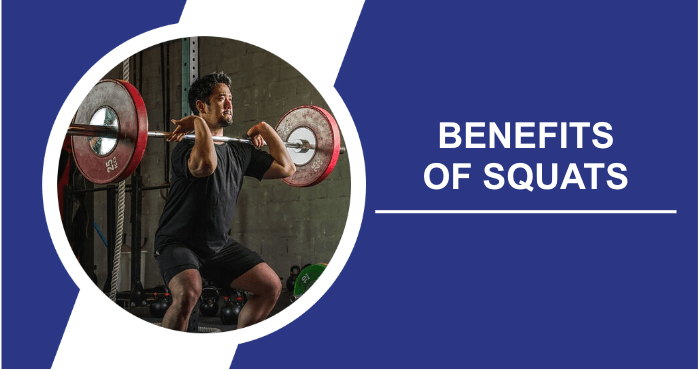Squats are one of the best compound exercises for building strength and mass. Besides working the complete lower body, squats also work your core, back, and stabilizer muscles, which keep your posture stable during basic movements required for daily tasks.
So now that we know squats are excellent for building muscles and boosting the overall ability to do basic life tasks, do they do more than help to gain muscles? This article will explain whether squatting can increase testosterone, which plays a huge role in energy, overall mood, the ability to gain or maintain muscle, and lots more. Do squats boost testosterone? Let’s find out!
Do Squats Increase Testosterone? What The Science Says
Squats, an essential strength training exercise, have been linked to a potential testosterone boost. Studies suggest heavy, compound movements like squats can temporarily increase testosterone levels after exercise. However, the increase is often short-lived and not substantial enough to drive significant muscle growth.
Comprehensive lifestyle changes, including diet, sleep, and exercise variety, are critical for sustained testosterone gains. While squats offer many benefits, relying on them alone for testosterone enhancement may not be the most effective strategy. Consult a fitness professional to tailor your workout routine for optimal results.
Who Is Particularly Affected By Low Testosterone Levels?
Low testosterone levels can affect people of all ages, but it is most common in middle-aged and older men. As men age, their natural testosterone production tends to decrease, leading to various symptoms such as fatigue, decreased libido, and muscle loss. But low testosterone isn’t limited to one gender or age group.
Women can also experience hormonal imbalances such as low testosterone, which can lead to decreased energy and mood swings. In addition, certain medical conditions and lifestyle factors, such as obesity or chronic stress, can contribute to low testosterone levels in both men and women. It’s essential to be aware of these potential effects and to seek medical advice for a balanced and healthy hormonal profile.
What Types Of Exercise Generally Help Increase Testosterone Levels?
Engaging in regular exercise can be a natural way to boost testosterone levels. Strength training exercises, such as weightlifting and resistance workouts, are efficient in increasing testosterone production. These activities challenge your muscles, prompting your body to release more testosterone to aid muscle repair and growth. Compound movements like deadlifts and bench presses are excellent choices besides squats.
Additionally, high-intensity interval training (HIIT) can also temporarily elevate testosterone levels. However, it’s crucial to strike a balance, as excessive exercise without adequate rest can lead to cortisol spikes, which can counteract the testosterone-boosting benefits. So, incorporating a well-rounded fitness routine while prioritizing recovery is key to maintaining hormonal harmony.
Can Squats Boost Testosterone?
They absolutely can! Squats are one of the most effective exercises, if not the absolute best, for promoting increased testosterone production. Multiple studies have confirmed that resistance training can indeed increase testosterone levels, but several factors come into play to determine the extent of this increase. Heavy resistance training has been shown to cause an almost immediate increase in serum testosterone levels, although they typically return to baseline within thirty minutes of exercise.
However, further research has shown that resistance exercises that focus on smaller muscle groups do not have the same impact on testosterone levels as exercises that target larger muscle groups, such as squats. In one particular study, scientists observed that performing single-arm dumbbell biceps curls had no discernible effect on plasma testosterone levels. In contrast, the group that performed leg and arm exercises experienced a significantly more significant increase in plasma testosterone and growth hormone levels.
The choice between free weights and machine weight training also plays a crucial role in determining the magnitude of the testosterone response to squats. One study examined the hormonal responses to barbell squats versus machine leg presses. Ten active weightlifters, averaging about 25 years of age, performed six sets of 10 repetitions for each exercise, one week apart.
It was found that the barbell squat produced more significant increases in testosterone and human growth hormone levels compared to the leg press. In addition, research has demonstrated that compound movements such as squats should be prioritized over other resistance exercises to optimize testosterone elevation.
One study examined the hormonal response to starting a workout with an extensive muscle group exercise followed by small muscle group exercises versus the reverse sequence. The results showed that starting with an extensive muscle group exercise, such as squats, increased serum testosterone and insulin-like growth factor (IGF-1). This result was attributed to squats engaging larger muscle groups, including the abdominal and stabilizer muscles.
Another critical determinant of how much squats can boost testosterone is the repetition range, volume of training, and rest period between sets. One study compared hormonal responses across a range of repetitions and rest periods and found that the most significant testosterone increases were achieved with ten repetitions and one minute rest between sets.
In addition, testosterone levels increased post-exercise and persisted for up to 30 minutes after exercise. To maximize your testosterone levels, consider incorporating free-weight squats as your first exercise, ideally aiming for the ten-repetition range with one minute of rest between sets. It’s important not to be too light on the weights; your ten reps should be challenging.
What Is Testosterone?
Testosterone is one of the androgenic hormones, classified as anabolic, responsible for the development and maintenance of male sex characteristics. While it primarily supports the growth of male characteristics, it’s worth noting that women also have lower levels of testosterone. The primary sources of testosterone production are the gonads, the testes in males, and the ovaries in females, with small amounts synthesized by the adrenal glands.
The crucial role of testosterone begins during fetal development and influences the determination of an individual’s sex at birth.
During puberty, males experience a significant increase in testosterone levels, which drives the development of primary and secondary male characteristics. These include growth in height, appearance of body and pubic hair, deepening of the voice, increased libido, and enlargement of the reproductive organs, particularly the prostate gland.
In adult men, testosterone continues to play a vital role in maintaining robust sexual function, promoting muscle growth, stimulating the production of new red blood cells, and contributing to overall health. In women, a significant amount of testosterone is naturally converted to the female sex hormone estradiol.
Although present in smaller amounts than in men, testosterone is still essential for women. It plays a crucial role in regulating their libido, harmonizing other hormonal processes, maintaining bone density, stimulating the production of new red blood cells, regulating the menstrual cycle, and contributing to overall well-being.
Squat Benefits
While squats are known for their ability to boost testosterone levels, they offer a variety of additional benefits. Aside from their hormonal effects, here are some notable benefits:
- Promoting muscle growth: Squats are a powerhouse for building muscle mass. They are a compound exercise that works several muscle groups, including the quadriceps, hamstrings, glutes, calves, abdominals, lower back, and stabilizing muscles. Exercises such as squats, which target multiple muscle groups simultaneously, are efficient for muscle development.
- Aid in weight loss: Research comparing the energy expenditure of eight popular resistance training exercises, including half-squats, incline leg presses, leg extensions, bench presses, incline bench presses, lat pulldowns, triceps extensions, and biceps curls, showed that half-squats burned significantly more calories than any of the other exercises. This makes squats a valuable addition to weight loss programs.
- Posture improvement: When performed with proper form, squats are among the best exercises for improving posture. They heavily involve the core muscles, including the abdominals, obliques, lower back, and erector spinal muscles, responsible for maintaining a straight back and good posture. Core stabilizer muscles help maintain balance during squats, further improving posture.
- Improved flexibility: Squats, when performed with a full range of motion and proper technique, contribute to increased joint strength and flexibility in the knees, hips, and ankles. This improvement in joint health translates into improved mobility for daily activities.
- Supporting bone health: A study examining the effects of multi-joint exercises such as squats, bench presses, and deadlifts on bone mineral density in college-aged individuals found that compound exercises such as squats resulted in significant increases in bone mineral density.
- Cardiovascular benefits: Squats, a form of high-intensity resistance training, engage multiple muscle groups and increase heart rate. This cardiovascular effect is essential for maintaining a healthy heart, making squats a valuable contributor to overall cardiovascular health.
Signs Of Low Testosterone
As men age 30, their testosterone levels typically decline at about 1% annually. Similarly, women experience a significant decline in testosterone levels, with levels dropping to about half of their peak levels by the time they reach menopause around age 50. If you’re experiencing any of the following signs, you may have low testosterone:
Common signs of low testosterone in both men and women include:
- Low libido or decreased sex drive
- Fatigue and a constant feeling of being tired
- Loss of muscle strength and tone
- Difficulty concentrating or reduced mental clarity
- Thinning hair
- Infertility (in men)
- Erectile dysfunction (in men)
- Depression or increased anxiety
- Dry and brittle skin
- Sleep disturbances, including difficulty falling asleep or staying asleep
In addition to these common symptoms, women with low testosterone levels may also experience:
- Irregular menstrual cycles
- Vaginal dryness
- Infertility or difficulty getting pregnant
Suppose you recognize several of these signs in yourself. In that case, it is advisable to consult a healthcare professional for a proper evaluation and guidance on potential treatment options for low testosterone levels.
Additional Methods To Boost Testosterone
We understand that not everyone can do squats or intense resistance training. Fortunately, there are alternative approaches to boosting testosterone production naturally. These methods include:
Participating In Regular Running Or Exercise
If resistance training and weightlifting are not your preferred activities, you can still boost testosterone levels through exercise. Research has shown that aerobic exercise, such as running, can increase testosterone levels.
Consistent physical activity has been shown to reduce BMI and increase serum testosterone levels. Studies have shown that high-intensity interval training (HIIT) can also positively affect testosterone. You can even combine running and high-intensity exercise by exploring HIIT treadmill workouts.
Eat A Healthy Diet
One of the simplest ways to regulate and increase testosterone levels is to eat a balanced diet. A protein-rich diet, green leafy vegetables, and healthy fats help maintain high testosterone levels.
Testosterone Boosting Foods
Numerous foods have been identified as potential testosterone boosters, including eggs, tuna, beans, pumpkin seeds, garlic, olive oil, beef, green leafy vegetables, pomegranate, fatty fish, cocoa products, shellfish, avocados, cherries, and berries.
Establish A Consistent Sleep Schedule
Maintaining a proper sleep schedule is critical to maintaining elevated testosterone levels. A 2011 study found that individuals who slept five hours or less experienced a 10-15% decrease in testosterone levels. Getting enough sleep is essential for building muscle and optimizing testosterone.
Herbs, Vitamins, Minerals
Scientific research has identified several vitamins, minerals, and herbs that naturally boost testosterone levels. These supplements include vitamin D, B6, zinc, magnesium, ashwagandha, and fenugreek. One effective strategy is to take a testosterone booster that combines a blend of high-quality vitamins, minerals, and herbs to maximize testosterone levels.
What Is The Best Testosterone Booster?
In the realm of testosterone booster supplements, our preference leans toward natural products, which we consider the safest and most effective option. Numerous studies have validated the effectiveness of natural herbs, minerals, and vitamins in boosting testosterone levels. Typically, natural testosterone boosters contain a blend of these scientifically backed ingredients.
We steer clear of products that contain synthetic compounds or hormones, as they may contain illegal or potentially harmful substances. For those seeking an alternative to testosterone boosters, there is also testosterone replacement therapy (TRT), a treatment administered under the guidance of a healthcare professional.
TRT uses prescription hormones to facilitate an increase in testosterone levels. Exploring options among the best online TRT clinics can be a wise choice. One of the most influential and convenient TRT providers is Fountain TRT. You can access their online TRT evaluation through this link to begin the process. You can read our comprehensive Fountain TRT review for additional insight into Fountain TRT.
What Supplements Increase Testosterone Levels?
Boosting testosterone levels naturally often means incorporating specific supplements into your routine. Among these, ashwagandha, a potent adaptogen, has gained popularity for its ability to support hormonal balance. In addition, fenugreek, a common spice, has been linked to increased testosterone levels and improved overall vitality.
Vitamin D, often called the “sunshine vitamin,” is critical in regulating testosterone production. In addition, zinc, a mineral found in several foods, supports healthy testosterone levels and sperm quality. While these supplements can be beneficial, consulting with a healthcare professional is vital to determine the right approach for your specific needs and goals.
Frequently Asked Questions
How soon after squatting does testosterone increase?
Research shows that testosterone levels increase immediately after squatting.
What are the signs of elevated testosterone levels in men?
Elevated testosterone levels are characterized by increased libido, muscle mass, strength, accelerated hair growth, deepened vocal tone, oily skin, reduced body fat, and possibly mood swings or increased aggression.
Can deadlifting increase testosterone production?
Incorporating deadlifts into your workout routine is one of the most effective ways to stimulate testosterone production because it works for different muscle groups throughout the body.
Do push-ups have a testosterone-boosting effect?
Yes, push-ups can increase testosterone levels because they involve several major muscle groups, including the chest, shoulders, triceps, abdominals, and stabilizing muscles.
Which exercise provides the most significant testosterone boost?
Scientific studies suggest that squats provide the most significant testosterone boost, especially as the first exercise in your workout routine, with a total training load in the ten-repetition range.
Final Thoughts
Research indicates that squats are the most effective exercise for increasing testosterone levels. Testosterone plays a crucial role in both men’s and women’s growth, development, and overall health.
Since natural testosterone levels tend to decline after the age of 30, it is important to use natural methods such as squats to increase these levels. Squats are high-intensity exercises that engage large muscle groups and promote multi-joint movements, facilitating muscle development.
Squats target the lower body, back, core, and stabilizing muscles, helping to improve balance and flexibility. Studies have shown that squats require more energy and result in a greater increase in serum testosterone levels compared to exercises such as leg presses. In addition, squats offer other health benefits, making them a valuable addition to any fitness routine.
Source
- Riachy, Ruba, et al. “Various Factors May Modulate the Effect of Exercise on Testosterone Levels in Men.” Journal of Functional Morphology and Kinesiology, vol. 5, no. 4, 7 Nov. 2020, p. 81. Read more
- Hansen, S., et al. “The Effect of Short-Term Strength Training on Human Skeletal Muscle: The Importance of Physiologically Elevated Hormone Levels.” Scandinavian Journal of Medicine & Science in Sports, vol. 11, no. 6, 1 Dec. 2001. Read more
- Shaner, Aaron A., et al. “The Acute Hormonal Response to Free Weight and Machine Weight Resistance Exercise.” Journal of Strength and Conditioning Research, vol. 28, no. 4, Apr. 2014. Read more
- Sheikholeslami-Vatani, Dariush, et al. “Comparison of the Effects of Resistance Exercise Orders on Number of Repetitions, Serum IGF-1, Testosterone and Cortisol Levels in Normal-Weight and Obese Men.” Asian Journal of Sports Medicine, vol. 7, no. 1, 1 Mar. 2016. Read more
- Kraemer, W. J., et al. “Hormonal and Growth Factor Responses to Heavy Resistance Exercise Protocols.” Journal of Applied Physiology, vol. 69, no. 4, 1 Oct. 1990. Read more
- Reis, Victor Machado, et al. “Energy Cost of Isolated Resistance Exercises across Low- to High-Intensities.” PLOS ONE, vol. 12, no. 7, 24 July 2017, p. e0181311. Read more
- Almstedt, Hawley C, et al. “Changes in Bone Mineral Density in Response to 24 Weeks of Resistance Training in College-Age Men and Women.” Journal of Strength and Conditioning Research, vol. 25, no. 4, Apr. 2011. Read more
- Yeo, Jeong Kyun, et al. “Which Exercise Is Better for Increasing Serum Testosterone Levels in Patients with Erectile Dysfunction?” The World Journal of Men’s Health, vol. 36, no. 2, 2018, p. 147. Read more
- Leproult, Rachel. “Effect of 1 Week of Sleep Restriction on Testosterone Levels in Young Healthy Men.” JAMA, vol. 305, no. 21, 1 June 2011, p. 2173. Read more
Mark Willson, holding a Ph.D., functions as a psychotherapist in Washington, D.C. His specialized fields encompass addiction, anxiety, depression, as well as sexuality and interpersonal connections. Dr. Willson holds the distinction of being a diplomat for the American Board of Addiction and Anxiety, further serving as a certified counselor and addiction specialist.
Aside from his personal professional endeavors, Dr. Wilson has engaged in roles as an author, journalist, and creator within substantial medical documentary projects.
Isabella Clark, Ph.D., held the position of a professor within Emory University’s School of Medicine, working in the Department of Mental Health and Nutrition Science. Alongside this role, she served as a research associate affiliated with the National Research Center. Dr. Clark’s primary area of research centers on comprehending the mechanisms through which adverse social encounters, encompassing prolonged stress and traumatic exposure, contribute to a spectrum of detrimental mental health consequences and coexisting physical ailments like obesity. Her specific focus lies in unraveling the reasons behind the varying elevated susceptibility to stress-linked disorders between different genders.





